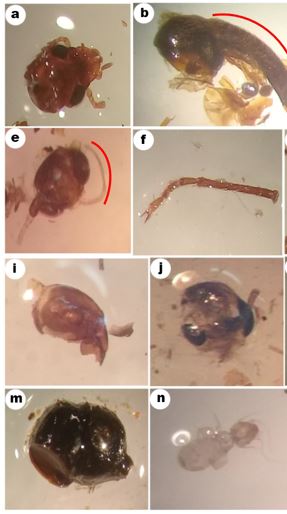Abstract
The Mato Grosso dog-faced bat (Neoplatymops mattogrossensis) is very poorly known. We present data on their natural history (population structure, temperature and relative humidity inside and outside the shelters, diet based on the analysis of fecal samples) obtained in shelters on the the San Sebastián Private Reserve of Natural Heritage. The shelters found were inhabited by between 1-10 individuals and in more than 70% of the shelters there is a single scrotal adult male. Temperatures inside shelters tend to be more stable than outside, but relative humidity is not. The diet is composed of Insecta, Arachnida, with Coleoptera as the most frequent followed by Lepidoptera and Hemiptera.
References
Acosta LHS, Azurduy HF, Sánchez G, Cortez E. 2006. Primer registro Neoplatymops Mattogrossensis (Viera, 1942) (Chiroptera), en Bolivia. Kempffiana 2(1):134-139.
Anthony ELP, Kunz TH. 1977. Feeding strategies of the little brown bat, Myotis lucifugus in Southern New Hampshire. Ecology 58(4):775-786. https://doi.org/10.2307/1936213
Avilla LS, rozensztranch AMS, Abrantes ÉAL. 2001. First record of the South American Flat-Headed Bat Neoplatymops mattogrossensis (Vieira, 1942) in Southeastern Brazil (Chiroptera, Molossidae). Boletim do Museu Nacional, Rio de Janeiro 463:1-6.
Borror DJ, Triplehorn CA, Johnson NF. 1989. An introduction to the study of insects. Saunders college publishing.
Borror DJ, White RE. 1970. A field guide to insects: America north of Mexico. Houghton Mifflin Harcourt.
Carvalho WD, Martins MA, Dias D, Esbérard CEL. 2013. Extension of geographic range, notes on taxonomy and roosting of Histiotus montanus (Chiroptera: Vespertilionidae) in southeastern Brazil. Mammalia 77(3):341-346. https://doi.org/10.1515/mammalia-2012-0012
de Paz O, Benzal J. 1989. Clave para la identificación de los murciélagos de la Península Ibérica (Mammalia, Chiroptera). Miscelánia Zoológica 13:153-176.
Díaz MM, Linares García VH. 2012. Refugios naturales y artificiales de Murciélagos (Mammalia: Chiroptera) en la selva baja en el Noroeste de Perú. Gayana 76(2):117-130.
Dietz C, von Helversen O. 2004. Illustrated identification key to the bats of Europe. Tuebingen & Erlangen. Germany.
Eisenberg JF, Redford KH. 1999. Mammals of the Neotropics: Ecuador, Peru, Bolivia, Brazil. University of Chicago.
Emmons LH, Feer F. 1999. Mamíferos de los Bosques Húmedos de América Tropical: Una guía de campo. Editorial FAN. Santa Cruz de la Sierra, Bolivia.
Flores-Martínez JJ, Ortega J, Ibarra-Manríquez G. 2000. El hábito alimentario del murciélago zapotero (Artibeus jamaicensis) en Yucatán. Revista Mexicana de Mastozoología 4(1):22-39.
Gregorin R. 1998. Notes on the geographic distribution of Neoplatymops mattogrossensis (Vieira, 1942) (Chiroptera, Molossidae). Chiroptera Neotropical 4(1):88-89.
Hill JE, Smith JD. 1984. Bats: A Natural History. British Museum (Natural History). London.
Jones G. 1990. Prey Selection by the Greater Horseshoe Bat (Rhinolophus ferrumequinum): Optimal Foraging by Echolocation? Journal of Animal Ecology 59(2):587-602. https://doi.org/10.2307/4882
Kunz TH. 1974. Feeding ecology of a temperate insectivorous bat (Myotis velifer). Ecology 55:693-711. https://doi.org/10.2307/1934408
Kunz TH. 1982. Ecology of bats. Plenum Publishing Corporation. Springer New York, NY.
Linares OJ. 1987. Murciélagos de Venezuela. Cuadernos Lagoven. Venezuela.
Linares OJ, Escalante A. 1992. A new subspecies of the South American flat-headed bat (Neoplatymops mattogrossensis) from Southern Venezuela. Mammalia 56(3):417. https://doi.org/10.1515/mamm.1992.56.3.417
Lizarro D, Aguirre LF, Pérez-Zubieta JC, Vargas A, Galarza MI. 2020. Characterization of caves as bat roosts in the brazilian-paranense biogeographic region of Bolivia. Therya 11(3):390. https://doi.org/10.12933/therya-20-1008
Muñoz-Arango J. 2001. Los murciélagos de Colombia: Sistemática, Distribución, Descripción, Historia Natural y Ecología. Universidad de Antioquia, Ciencia y Tecnología.
Novaes RLM, Laurindo RDS, Souza RDF. 2015. Structure and natural history of an assemblage of bats from a xerophytic area in the Caatinga of northeastern Brazil. Studies on Neotropical Fauna and Environment 50(1):40-51. https://doi.org/10.1080/01650521.2015.1006478
Nowak RM. 1999. Walker's Mammals of the World. The Johns Hopkins University Press. Baltimore, London.
Ortiz-Von Halle B, Alberico M. 1989. Primer registro de Neoplatymops mattogrossensis (Cunha Vieira 1942)(Chiroptera: Molossidae) en territorio colombiano Trianea. Trianea 3:263.
Peterson RL. 1965. A review of the flat-headed bats of the family Molossidae from South America and Africa. Life sciences contributions Royal Ontario Museum 64:1-62. https://doi.org/10.5962/bhl.title.52228
Ruiz A, Santos M, J. SP, Cavelier J, Cadena A. 1997. Relaciones Mutualísticas entre el Murciélago Glossophaga longirostris y las Cactaceas Columnares en la zona árida de la Tatacoa, Colombia. Biotropica 29(4):12. https://doi.org/10.1111/j.1744-7429.1997.tb00041.x
Sazima I, Taddei VA. 1976. A second Brazilian record of the South American flat-headed bat, Neoplatymops mattogrossensis. Journal of Mammalogy 57(4):757-758. https://doi.org/10.2307/1379448
Schorr RA, Siemers JL. 2013. Characteristics of roosts of male pallid bats (Antrozous pallidus) In Southeastern Colorado. The Southwestern Naturalist 58(4):470-516. http://dx.doi.org/10.1894/0038-4909-58.4.470
Siles L. 2007. Familia Molossidae. In: Aguirre, LF, editors. Historia Natural, Distribución y Conservación de los Murciélagos de Bolivia. Fundación Simón I. Patiño, Santa Cruz, Bolivia. p.400.
Silva-Taboada G. 1979. Los Murciélagos de Cuba. Academia de Ciencia. La Habana, Cuba.
Solari S. 2019. Molossops mattogrossensis. http://dx.doi.org/10.2305/IUCN.UK.2019-1.RLTS.T13640A22109057.en. 15, Mayo Access Date.
Sutherland WJ. 2000. The conservation handbook: research, management and policy. Blackwell Science John Wiley & Sons. Oxford.
Tirira DG. 1998. Biología, sistemática y conservación de los mamíferos del Ecuador, Memorias. Pontificia Universidad Católica del Ecuador. Quito, Ecuador.
Torres-Flores JW, López-Wilchis R, Soto-Castruita A. 2012. Dinámica poblacional, selección de sitios de percha y patrones reproductivos de algunos murciélagos cavernícolas en el oeste de México. Revista de Biología Tropical 60(3):1369-1389.
Vides-Almonacid R, Reichle S, Padilla F. 2007. Planificación Ecorregional del Bosque Seco Chiquitano. Fundación para la Conservación del Bosque Chiquitano-The Nature Conservancy. Santa Cruz de la Sierra, Bolivia.
Vieira COC. 1942. Ensaio monográfico sobre os quirópteros do Brasil. Arquivos de Zoologia do Estado de São Paulo 3(8):219-471.
Whitaker JO. 1995. Food of the Big Brown Bat Eptesicus fuscus from Maternity Colonies in Indiana and Illinois. The American Midland Naturalist 134:346-360. https://doi.org/10.2307/2426304
Whitaker JO, Neefus C, Kunz TH. 1996. Dietary Variation in the Mexican Free-Tailed Bat (Tadarida brasiliensis mexicana). Journal of Mammal 77(3):716-724. https://doi.org/10.2307/1382676
Willig MR. 1985a. Ecology, Reproductive Biology, and Systematics of Neoplatymops mattogrossensis (Chiroptera: Molossidae). Journal of Mammalogy 66(4):618-628. https://doi.org/10.2307/1380788
Willig MR. 1985b. Reproductive activity of female bats from northeast Brazil. Bat Research News 26(2):17-20.
Willig MR, Jones JK. 1985. Neoplatymops mattogrossensis. Mammalian Species 244:1-3. https://doi.org/10.2307/3504056
Wood JRI, Mamani F, Soto D. 2011. Guía Darwin de las plantas de los Cerrados de la Chiquitania. Darwin Initiative. Santa Cruz, Bolivia.

This work is licensed under a Creative Commons Attribution 4.0 International License.






